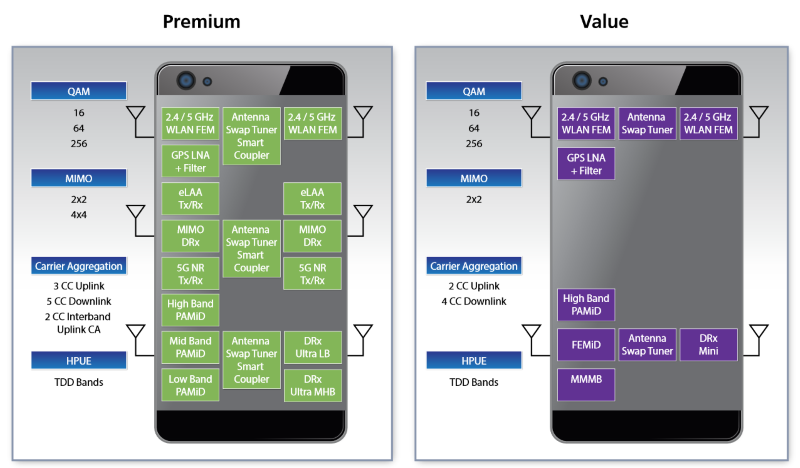The industry is moving at a fast pace to provide 5G services to end users. The initial 5G deployments have started with 5G Fixed Wireless Access (FWA) networks in some countries. But the availability of Consumer Premise Equipment (CPE) is limited and only Huawei and Samsung are offering CPE’s. The real potential of 5G will be delivered by Stand Alone (SA) 5G which will enable Ultra-Reliable Low Latency Communication (uRLLC), a wholly new form of wireless communications capability.
5G brings a new set of possibilities for wireless networks, but also poses a challenge for the mobile ecosystem players to meet set timelines. In addition, 5G smartphones will also introduce challenges including high bandwidth, Multiple Input Multiple Output (MIMO), higher peak to average power ratio and frequency congestion because of carrier aggregation and many more. Some key challenges that will likely hinder the availability of 5G capable smartphones include:
Radio Frequency Front End (RFFE) and Baseband Complexity
Initial 5G smartphones will operate on 5G Non-Stand Alone (5G NSA) networks. They will require multi-mode (2G, 3G, 4G, 4.9G, 5G NSA) operation that will support legacy network capabilities for fallback until we have ubiquitous 5G coverage.
In addition to this, mmWave support will make Radio Frequency (RF) integration and antenna positioning more complicated. At mmWave frequencies the wavelength is so small that the radio waves can be easily blocked by hands, objects or walls making the RF Rx & Tx capabilities on the phone extremely challenging.
This in turn, will result in additional complexities for Radio Frequency Front End (RFFE) suppliers, particularly Power Amplifier (PA)s, filters and antennas. Many existing 3G/4G bands will have to be reframed for 5G and this may take years, depending on the country. Therefore, the RFFE will be needed to efficiently support multiple bands dynamically adding even more complexity for RFFE suppliers and handset design teams.
One of the key requirements for 5G NR is support for massive MIMO. In 3GPP Rel. 15, 5G NR massive MIMO is supported with 32 antennas and is expected to increase up to 64 antennas or more. Adding 4×4 MIMO in smartphone means adding more components into an already crowded space allocated to the RFFE, since multiple antennas will be required, and that many independent RF pathways will be needed. This will be challenging as it will be difficult to add more antennas in a smartphone and deal with space and interference losses. The latest smartphone designs with full screen displays and metal frames further limits the ability to add more antennas to the smartphone.
In a nutshell, 5G brings many benefits but will come with tough implementation problems that industry players are relentlessly trying to solve in time to accelerate 5G commercialization.

Image source: EETimes
High processing power and AI requirements:
A 5G capable smartphone will need about 5x more processing power, consume 2.5x more power and see board sizes increase by around 1.3x times. This will lead to a larger System on Chip (SoC). Reducing the size of the SoC is a major hurdle and it means that initial 5G smartphones will likely have a standalone or discrete 5G baseband. SoCs with integrated 5G basebands will arrive later.
OEM’s like Huawei are working on building ASIC-based 5G chips for smartphones. Adding ASICs and the need for high computing capability will mean the devices produce lots of heat, and therefore will need an efficient cooling system. Again, this will have a significant impact on the overall design of the smartphone. Many current flagship devices are effectively sealed to comply with IP67 water and dust resistance, further limiting the ability for the device to shed heat.
To efficiently use massive MIMO, beamforming is a key technique. The different beamforming schemes require an advanced channel state information (CSI) mechanism to handle the specific architecture and require the use of codebooks to work with multi-panel antennas. To manage these, machine learning can be employed that optimizes beam forming and link adaptation dynamically via an on-device or cloud based neural network (NN). Intelligent front-ends will be key to driving efficiencies for next generation smart devices and this adds additional requirements for 5G NR based smartphones, potentially increasing the BOM cost of the device. Moreover, larger batteries will be required for 5G smartphones to support the high-power requirements and richer content consumption on what could be larger display smartphones.
This significantly increases the potential cost and hence price of 5G smartphones, limiting 5G initially to ultra-premium categories. It will take a few years for them to trickle down to the high-end segment, at which point the market for 5G smartphones will begin to accelerate.
Standards, Testing and Timelines
The initial 5G NR capable smartphones will work in 5G NSA mode. Full 5G SA will require compliance with 3GPP Release 16 standards that are unlikely to be finalized until 2020 and likely not widely adopted commercially until 2023. Release 16 will also see many of the 5G elements that support advanced IoT applications.
Aggressive deadlines for 5G NSA and availability of smartphones in the first half of 2019 leaves players with tight schedules to properly test the devices in real-life situations and then deliver them to end users. However, with major achievements and breakthroughs like the availability of the mmWave module QTM052 from Qualcomm, will help reduce test times and speed availability of devices.
Various OEM’s have announced the availability of the 5G NR capable smartphones in the first half of 2019, many using Qualcomm chipsets. However, Samsung and Huawei are not far behind in the 5G game with possibly the first 5G smartphones to launch in 2H 2019. MediaTek and Intel-based smartphones should be commercially available in 2020. The 5G handset market is expected to show slow growth until at least 2020 due to the transition from NSA to SA, the paucity of networks capable of supporting them and their relatively high price. Nevertheless, looking further ahead, we expect around 26% of the total handset shipments in 2025 will be 5G capable.
To view the complete report, click here.

